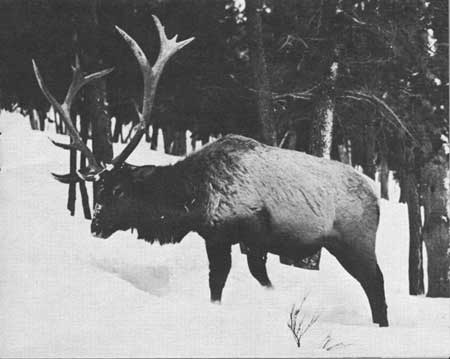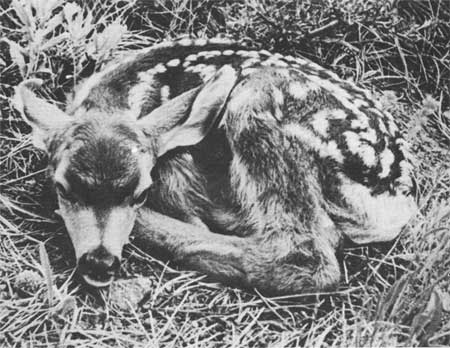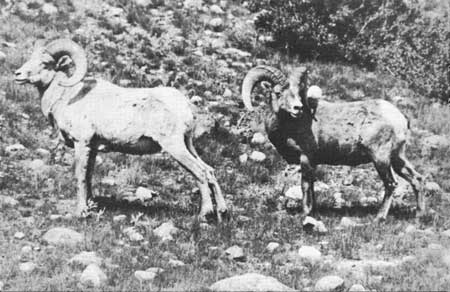|
ROCKY MOUNTAIN National Park |
 |
Animal Life
A national park is a spacious natural reserve, and in it those creatures which have survived through the past are protected from harm by humans. They are not protected from each other, there being no attempt to change natural relationships of predator and prey.
Since the animals are in their natural habitats, and not in cages, you may not be able to see at close range the kinds of animals you may want to see at any time you like. Instead, you must carefully watch for them at their convenience, not yours. This requires a bit of time, but is a boon to the observant outdoorsman. An occasional glimpse of a bull elk grazing free in his native meadow may be more satisfying than the most detailed inspection of a confined creature in a zoological garden. Our society needs both types of experiences.
Although there are about 35 species of mammals in the park, this booklet can present brief descriptions of only a few of those likely to be of greatest interest.
 ALTHOUGH ELK, ESPECIALLY THE BULLS, OCCASIONALLY STAY HIGH IN THE DEEP SNOW BELT, MOST OF THEM FEED IN LOWER MEADOWS DURING THE WINTER. |
HOOFED ANIMALS
The largest of our mammals is known either as ROCKY MOUNTAIN ELK, or WAPITI. We shall use the name, elk, in this booklet. It is really a "big deer"—distinctly larger than our local mule deer and usually with a more reddish or brownish coat. The elk were almost exterminated here by ruthless hunting in prepark days. Small bands introduced here in 1913 and 1914 from Yellowstone National Park made possible the present herd of over 800 elk.
During summer, the elk are usually high in the mountains taking advantage of the lush grass of the widespread tundra or the forest glades. Their food consists mostly of grass, herbs, and twigs of woody plants. The summer is a short but prosperous time for these animals. Usually by early autumn, fierce storms in the high country put an end to days of ample forage and most of the elk move down into the relatively small and few lower meadows. In late September, as the mating season begins and the bulls fight for possession of the herds, large groups of elk can be seen in such places as Horseshoe Park and Beaver Meadows. This is when the challenging bugle of the bulls can be heard, echoing across the valleys. In November, this period ends and the more prosaic struggle for survival on the limited winter range begins.
Formerly, during the winter, the elk could scatter well below the present site of Estes Park village; now they are "bottled up" within the park meadows, because of the encircling human developments. Or perhaps these introduced elk and their descendants never developed a more extensive winter migration pattern, for the more venturesome individuals among them would have been killed or harried by hunters in the lower country east of the park. In any case, today the bulk of them do not move out of the park.
Times are hard for the elk until spring permits their return to the high country, where ample feed awaits them. Grave concern is felt by wildlife experts about the winter food shortages confronting this species. Without deliberate control by the park rangers, in order to keep the population at a level which can be supported by the limited and overused vegetation of the park's winter ranges, the herd itself would face mass starvation. The absence or near disappearance from this region of some of the most effective predators of the elk—the mountain lion, wolf, and grizzly bear—has removed most of the aboriginal population controls.
Whether you visit the park in summer or winter, you should be able to see elk—at least with binoculars. In summer (especially in the evenings) you may see them along the Trail Ridge Highway, emerging from the forests below Fall River Pass or the Rock Cut area. The cirque below the Fall River Pass exhibit room is a good place to look for them with binoculars. From mid-September until March or April, herds of elk are normally to be seen in Beaver Meadows, Horseshoe Park, and in the meadows north of Grand Lake, but it often requires patience and some keenness as an observer.
 MULE DEER ARE COMMON. THE FAWNS, BORN IN EARLY JUNE, ARE SPOTTED WHEN YOUNG. —Fred Packard photo. |
It should be easier to see the MULE DEER which are a familiar sight in many areas in early morning or evening, even in midsummer. Hikers encounter them on the trails throughout the park. When alarmed, they escape, characteristically bounding from all four feet at once and hopping away in graceful jumps. This odd movement is helpful for ascending rocky slopes and in traversing brush and tall herbage.
The males of both deer and elk grow antlers annually. For a short period in late winter and spring they have no antlers at all, but by June the new growths begin, getting larger and larger until August, when they attain full size. Until then, the antlers are "in velvet"—with a soft, hairy covering—which dries up and peels or is rubbed off. Often the animal is aided by rubbing the antlers against trees and branches. Many "rubbing" trees can be seen along the trails. With polished, full-sized antlers, the mating season is entered, and these majestic adornments are worn until the season of shedding. Most of the discarded antlers contain much salt and calcium and are eaten by porcupines and other rodents. Therefore, few shed antlers are seen by visitors, although at first thought one would expect to find them everywhere.
During the summer, deer are seen singly or in small groups browsing in the higher country, and, like the elk, descend into the lower meadows in autumn. They, too, find the winter difficult, because of limited range. Deer are browsing animals eating such things as willow, aspen, antelope bitterbrush, and even pine needles. Much of their natural food has been overbrowsed, and this condition has helped to make "beggars" of many of them. It is not unusual to see them in the streets of Estes Park village or near the town garbage dump looking for something to eat. June, however, brings the lush green vegetation on which they regain their strength. That month also is the fawning time. The spotted youngsters are usually hidden in the woods and are nursed twice a day by the mother, who stays nearby but out of sight. Sometimes well-meaning visitors report an abandoned baby deer. In most instances, the fawn has not been abandoned; the visitors merely failed to see the mother in the background. Fawns, which keep their spots until autumn, run with the mother until the next spring.
 THE MALE BIGHORN DISPLAY THE HORNS WHICH HAVE MADE THEM FAMOUS. |
The greatest thrill for many park visitors is when a BIGHORN, or MOUNTAIN SHEEP, comes close enough to be photographed; however, those occasions are rare. Like most wild animals of the West, the bighorn was on the verge of extinction 40 years ago, but, thanks to various conservation measures, it is no longer in jeopardy. Formerly, bighorns were distributed throughout the park and beyond to the foothills. Today, they are largely restricted, by man's necessary settlement of the land, to portions of the park remote from man's developments. Most visitors—when they get to see them at all—spot bighorn near Milner Pass, on the Trail Ridge Road, on Specimen Mountain, or in the Mummy Range. During June, and again in the autumn, they are sometimes seen near Sheep Lake (in Horseshoe Park), usually in small family groups of ewes and lambs. Most successful pictures of them have been made in this vicinity in the early morning.

|

|
|
|
|
Last Modified: Sat, Nov 4 2006 10:00:00 pm PST |


